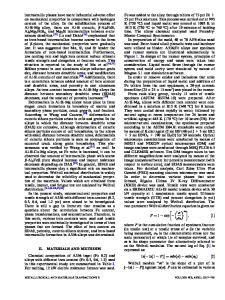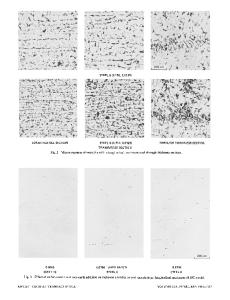Influence of Alpha Nanoalumina Reinforcement Content on the Microstructure, Mechanical and Corrosion Properties of Al606
- PDF / 2,012,598 Bytes
- 10 Pages / 593.972 x 792 pts Page_size
- 102 Downloads / 385 Views
JMEPEG DOI: 10.1007/s11665-017-2893-2
Influence of Alpha Nanoalumina Reinforcement Content on the Microstructure, Mechanical and Corrosion Properties of Al6061-Al2O3 Composite Vikas Shrivastava, Swati Dubey, Gaurav Kumar Gupta, and I.B. Singh (Submitted March 30, 2017; in revised form August 3, 2017) Sol–gel prepared nanoparticles of alpha alumina were mixed in their varying weight percentage (0.5, 1, 1.5, 2 and 2.5 wt.%) with Al-6061 powder for synthesizing of Al6061-Al2O3 nanocomposites using powder metallurgy route. After sintering at 610 °C, microstructural, mechanical and corrosion properties of the composite samples were evaluated to see the effect of nanoalumina reinforcement content on these properties. Microstructural examination of the composites indicated the uniform distribution of nanoparticles up to their 2 wt.% content. Above this amount, distribution of nanoparticle attained saturation level and their accumulation started in the grain boundary regions. It is found that by increasing the nanoparticles content, the hardness and strength first increase and then decrease when amount of nanoparticle exceeds 2 wt.%. Reinforcement of 0.5-1 wt.% nanoparticle content has shown excellent corrosion resistance of the synthesized composites in 3.5% NaCl solution. After 1 wt.% incorporation of nanoparticles, a gradual increase in corrosion rate with the increase in nanoparticle content was measured and corrosion becomes worse than that of the base alloy in the presence of 2.5 wt.% nanoparticle content. Solution heat treatment followed by ageing of the composite samples was found highly beneficial for the increase in hardness. Keywords
corrosion in 3.5% NaCl, mechanical properties, metal matrix composites, nanoalumina particles
1. Introduction Because of low density, high strength, high specific modulus, high stiffness and good wear and corrosion resistances, particulate reinforced aluminium metal matrix composites (AMMCs) are being considered as an ideal material for structural application in aircraft and automotive industries (Ref 1-9). Increase in weight percentages from 1 to 10 of ceramic reinforcement particulates is observed to influence the mechanical properties of the AMMCs noticeably (Ref 5, 10-13). Reinforcement of ceramic particulates increases the dislocation barriers in the structure of the AMMCs that results increase in their strength (Ref 10, 14). At the same time, it decreases the ductility. On the other side, decrease in ceramic particulate sizes from micro- to nanoscale range increases strength of the composite products in a significant level (Ref 10, 15, 16). Because nanoparticulate occupies greater number of the same weight percentage of micron-sized particulates. At the same time, ductility of the composite is preserved because nanoparticulate is no longer fractured below a critical size (Ref 3, 8, 10). Due to the above reasons, reinforcement of nanoparticulate is receiving a considerable attention from the researchers for the synthesis of composite products of improved mechanical strength with c
Data Loading...











